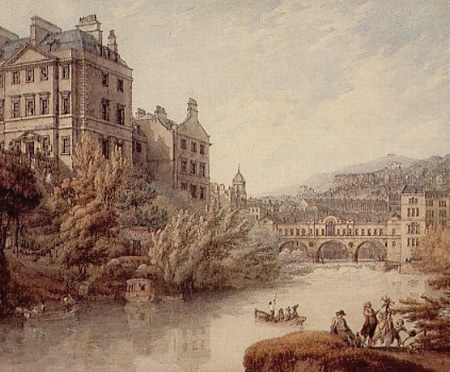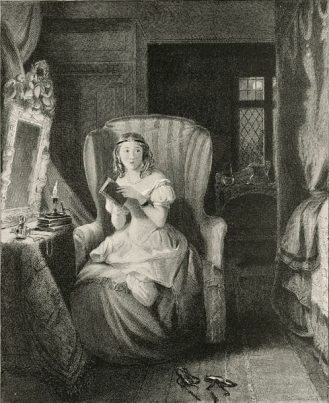 Harvard University Press is seriously spoiling me. With the release of Northanger Abbey: An Annotated Edition, they have now produced five glitzy coffee table editions of Jane Austen’s major novels. What true Janeite could possibly pass up an unabridged first edition text, an extensive introduction, and notes by an Austen scholar, full-color illustrations, over-sized hardcover format, and copious supplemental material – all wrapped up in a beautifully designed package? Not me!
Harvard University Press is seriously spoiling me. With the release of Northanger Abbey: An Annotated Edition, they have now produced five glitzy coffee table editions of Jane Austen’s major novels. What true Janeite could possibly pass up an unabridged first edition text, an extensive introduction, and notes by an Austen scholar, full-color illustrations, over-sized hardcover format, and copious supplemental material – all wrapped up in a beautifully designed package? Not me!
I have enjoyed all of the editions in this annotated series so far, with only one exception. I am greedy. I want more annotation and was quite annoyed when I turned a page of a previous edition and saw white space in the sidebar columns instead of text. Such a waste when there is so much to write about and Janeites and newbies are eager and grateful readers. The first thing I did when I cracked open this new edition was to skim for the dreaded white space. It looked plump and promising.
Northanger Abbey is indeed the wallflower of Austen’s oeuvre. Like its young heroine Catherine Morland, it is a naïve, wide-eyed debutant in comparison to its light, bright and sparkling older sister Pride and Prejudice. My heart sinks to admit it, but it is true. While readers continually rank it as one of Jane Austen’s least popular novels, I think it is one of her hidden gems—highly under-rated and completely satisfying. I find its exuberant humor laugh-out-loud funny, hunky hero Henry Tilney witty and irresistibly charming, and the spooky Gothic parody brilliant. Why is my reaction so different from the average reader’s? Knowledge. It is extremely helpful to be able to place the novel in a social context and to understand Austen’s layered tongue-in-cheek underpinnings. That’s where this new annotated edition comes in handy. I believe that editor Susan J. Wolfson has pulled together a masterpiece.

Thomas Hearne (1744-1817) View of Bath from Spring Gardens (1790)
In her 60-page introduction (including 7 pages of notes listing references sited) Wolfson takes us on an illuminating journey through the challenges Austen faced on the road to publication of Northanger Abbey—the first novel that Austen wrote in her twenties—and the last to be published after her death in December 1817.
“…the novel is an odd repository, of strange, uneven power…it has her youngest, most inexperienced, “strange, unaccountable” heroine, a girl “in the bloom of seventeen,” ushered by a mature, self-possessed narrator, and the only heroine, moreover, sent into the busy world, with promise and peril. On these pressure points and risky cross-purposes, Austen involved an amusing but conceptually complex relay of genres: a romantic comedy of manners and a parody of its conventions; a spoof of the gothic that also harbored an evident enjoyment of it—along with a glance at its credible language for anxieties that rational society won’t admit.” (Introduction, 10)
Wolfson also elaborates upon the historical context, Austen’s contemporaries, biographical background, her writing and publication career, and analysis of the novel formerly known as Susan, which would posthumously be renamed Northanger Abbey when it was published by John Murray in late 1817.
I found the introduction accessible and enlightening, the illustration well-chosen, with an equal mix of the familiar and the surprising, and the annotation refreshingly unpedantic. Readers new to Northanger Abbey will be taken on a heroine’s adventure of discovery, and those familiar with the path will be equally delighted to make their appearance in the Lower Rooms with Henry Tilney or frightened with Catherine Morland as she reads The Mysteries of Udolpho at Northanger Abbey.

R. W. Buss, Catharine Moreland, from Character Sketches of Romance, Fiction and the Drama (1892)
Was my desire for less white space and more text in the side columns fulfilled? Maybe. While this edition exhibited a vast improvement in quantity and quality, this Janeite will never be truly satisfied until every possible inch is utilized.
5 out of 5 Stars
Northanger Abbey: An Annotated Edition, by Jane Austen, edited by Susan J. Wolfson
Belknap Press (2014)
Hardcover (384) pages
ISBN: 978-0674725676
Our previous previews and reviews of the Harvard University Jane Austen series:
- Pride and Prejudice: An Annotated Edition, by Jane Austen, edited by Patricia Meyer Spacks
- Persuasion: An Annotated Edition, by Jane Austen, edited by Robert Morrison
- Preview of Emma: An Annotated Edition, by Jane Austen, edited by Bharat Tandon
- Sense and Sensibility: An Annotated Edition, by Jane Austen and edited by Patricia Meyer Spacks
Cover image courtesy of Belknap Press © 2014; text Laurel Ann Nattress © 2014, Austenprose.com
Disclosure of Material Connection: We received one review copy from the publisher in exchange for an honest review. We only review or recommend products we have read or used and believe will be a good match for our readers. We are disclosing this in accordance with the Federal Trade Commission’s 16 CFR, Part 255: “Guides Concerning the Use of Endorsements and Testimonials in Advertising.”
You make this book sound SO tempting. I just reread Northanger Abbey and was surprised by how much I loved it.
LikeLiked by 1 person
Yes!! Another Northanger Abbey enthusiast! It took me awhile to warm up to this great novel as much as the others, but after another read, then another…I truly love it. I think I was a bit put off by Catherine Morland at first, but then ‘fell in love’ with Henry Tilney. Thanks for the great article on the NA edition…hmm…I just received my beautiful copy of Emma, but NA will have to be next; (I know what you mean about white space). :o)
LikeLiked by 1 person
I fell for Henry Tinley too and he seems to me almost like a mix of the best of Elizabeth and Darcy–her wit and his decency. (Not that Elizabeth isn’t decent too.)
LikeLike
Northanger Abbey is much more layered and delightful than most people realize. It makes good use of the everyday “terrors” that selfish people impose upon the innocent, which is a good counterpoint to the terrors in Gothic novels. Our heroine must make important choices and act bravely throughout the book, and her goodness, while naive, passes all the tests placed in her way. And Henry Tilney is just wonderful — the most amusing and appealing Austen hero in my estimation. Only Fanny Price has to undergo more challenges to her goodness, but she ends up with Edmund who does not have a shred of wittiness in him!
LikeLike
This version sounds so good. I completely agree with you regarding knowledge of context etc, although we can enjoy Austen’s novels just as stories the enjoyment is magnified the more understanding we have of the other references within the text and the social context of the events in the stories.
LikeLike
A fine and inviting review indeed. There is something so charming and compelling about the dialogues between Henry and Catherine, some of JA’s best(?) And the way our naïve but plucky heroine navigates through a maze of some of Miss Austen’s most eccentric and colorful characters is high entertainment. Of all her stories, this one seems to be the most current and contemporary to me.
LikeLike